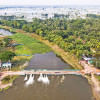Protect Bhabadaha from waterlogging

We are gravely concerned by the persistent waterlogging in Jashore's Bhabadaha area following the heavy rains in August. This area, in fact, has been plagued by waterlogging since the early 1980s, primarily due to the construction of embankments and sluice gates that disrupted the natural flow and dried up nearby rivers. In recent years, waterlogging has not only deteriorated in Bhabadaha but also spread to neighbouring areas. Currently, at least 300 villages in Jashore's Abhaynagar, Manirampur, and Keshabpur, Khulna's Dumuria and Phultala, and Satkhira's Sadar and Tala upazilas are grappling with severe waterlogging, affecting around 10 lakh people.
Reportedly, over 200 schools in these areas have been inundated, depriving thousands of children of education, while around 50,000 farmers in 10 upazilas of the three districts are facing uncertainty over growing the Boro crop this season, as about 96,000 hectares of farmland remain waterlogged. The situation is dire and requires proper interventions.
Unfortunately, the authorities have allowed this problem to persist for decades despite a proven solution being available: the Tidal River Management (TRM). Since 1982, the Bhabadaha Water Drainage Movement Committee has advocated TRM to policymakers, yet their calls have largely gone unheeded. Local influential figures, benefitting from shrimp farming in the waterlogged areas, have also obstructed efforts to address the issue, leaving farmers and ordinary residents to bear the brunt. Although the previous Awami League government implemented several projects spending crores of taka, these were not scientifically sound and failed to provide lasting solutions.
Pumping out water from the affected areas and dredging nearby rivers can offer only temporary relief, so locals need a permanent solution. That's why implementing TRM is crucial. Under this method, a canal, which connects a river to a beel, is dredged to allow river water to flow into the beel so that the sediment is carried in and the low-lying area is elevated. Some sediment is then carried back into the sea during low tide. This approach allows water to enter the beels for gradual land reclamation. Over time, the raised land within the embankment becomes higher than the surrounding riverbed. Local communities have previously implemented TRM in some beels with successful results, but political influences, including those of shrimp businessmen, have repeatedly hindered this approach.
Reportedly, if waterlogging continues even for a few more days, it will severely impact Boro crop cultivation for the next season. Therefore, immediate action is needed from the government. For a long-term solution, the government should begin implementing TRM in the region. It is promising that Syeda Rizwana Hasan, adviser to the environment ministry, has pledged to resolve the issue. We hope her words will soon translate into action.


 For all latest news, follow The Daily Star's Google News channel.
For all latest news, follow The Daily Star's Google News channel. 






Comments